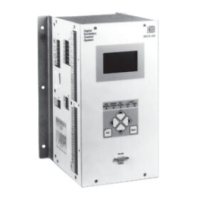5-16 BESTCOMS Software DECS-200
function provides reference gain settings for user-specified generator and/or exciter time constants. See
PID Window
for information about customizing stability settings.
Table 5-1. Predefined Stability Setting Groups
Setting
Group
Generator Open Circuit
Time
Constant (T’do)
Generator Exciter
Time Constant (Texc) Kp Ki Kd
1 1.0 0.17 42.20 115.2 4.433
2 1.5 0.25 66.50 150.0 8.750
3 2.0 0.33 87.16 167.9 13.670
4 2.5 0.42 104.50 175.8 18.960
5 3.0 0.50 119.00 177.8 24.500
6 3.5 0.58 131.30 176.4 30.220
7 4.0 0.67 141.80 173.1 36.060
8 4.5 0.75 150.90 168.8 42.000
9 5.0 0.83 158.80 163.9 48.010
10 5.5 0.92 165.70 158.7 54.080
11 6.0 1.00 171.80 153.6 60.200
12 6.5 1.08 177.20 148.5 66.350
13 7.0 1.17 182.10 143.6 72.540
14 7.5 1.25 186.50 138.9 78.750
15 8.0 1.33 190.50 134.4 84.980
16 8.5 1.42 194.10 130.1 91.230
17 9.0 1.50 197.40 125.9 97.500
18 9.5 1.58 200.40 122.1 103.800
19 10.0 1.67 203.20 118.4 110.100
20 10.5 1.75 205.70 114.8 116.400
AVR/FCR, Proportional Gain KP.
Selects the proportional constant (KP) stability parameter. The DECS-
200 provides an output value that is equivalent to KP multiplied by the error between the voltage setpoint
and the actual generator output voltage. Typical values of KP range from 0 to 1,000. General guidelines
for tuning KP are as follows: If the transient response has too much overshoot, decrease KP. If the
transient response is too slow with little or no overshoot, increase KP. A setting of 0 to 1,000 may be
entered in 0.1 increments.
AVR/FCR, Integral Gain KI.
Selects the integral constant (KI) stability parameter. The DECS-200 provides
an output value that is equivalent to KI multi-plied by the integral of the error between the voltage setpoint
and the actual generator output voltage. Typical values of KI range fro 0 to 1,000. Generally, if the time to
reach steady state is deemed too long, then increase the value of KI. A setting of 0 to 1,000 may be
entered in 0.1 increments.
AVR/FCR, Derivative Gain KD.
Selects the derivative constant (KD) stability parameter. The DECS-200
provides an output value that is equivalent to KD multiplied by the derivative of the error between the
voltage setpoint and the actual generator output voltage. A setting of 0 to 1,000 may be entered in 0.1
increments. Typical values of KD range from 1 to 10. If the transient response has too much ringing, then
KD should be increased.
AVR/FCR, Derivative Gain TD.
Removes the effects of noise on numerical differentiation. A setting of 0 to
1 may be entered in 0.01 increments. Typical TD values range from 0.01 to 0.03.
AVR/FCR, AVR Loop Gain Kg.
Sets the coarse loop-gain level of the PID algorithm for AVR mode. A
setting of 0 to 1,000 may be entered in 0.1 increments.
_AVR/FCR, FCR Loop Gain Kg. Sets the coarse loop-gain level of the PID algorithm for FCR mode. A
setting of 0 to 1,000 may be entered in 0.1 increments.

